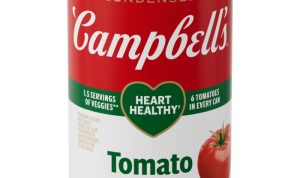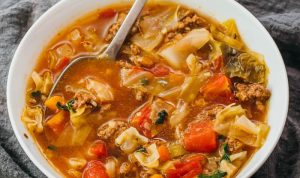A Culinary Exploration of Canned Vegetable Soups
Vegetable soup with canned vegetables recipes – Canned vegetables have long been a staple in kitchens worldwide, offering convenience and accessibility. Their role in soup-making, once viewed as a last resort, has evolved into a culinary technique appreciated for its efficiency and surprising versatility. This exploration delves into the art of crafting delicious and nutritious soups using canned vegetables, highlighting their benefits, recipe variations, and techniques for flavor enhancement.
Introduction to Canned Vegetable Soup Recipes
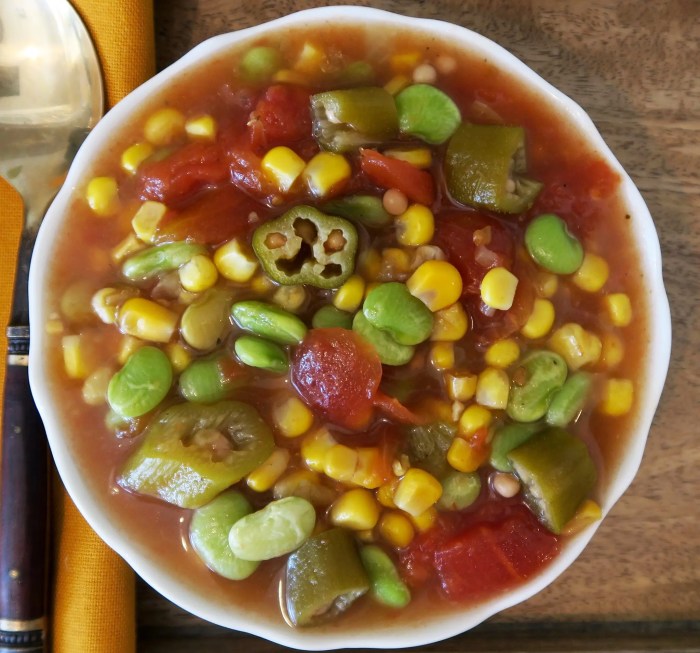
Source: margaretholmes.com
The use of canned vegetables in soup making dates back to the early 20th century, coinciding with the rise of commercial canning. Initially a practical solution for preserving seasonal produce, canned vegetables quickly became a convenient ingredient for quick meals. Today, they offer a reliable and readily available option for home cooks and chefs alike.
Three key benefits of using canned vegetables in soup recipes include their affordability, extended shelf life, and consistent quality. Canned vegetables are often less expensive than fresh produce, especially during off-season months. Their long shelf life reduces food waste and allows for spontaneous soup preparation. Furthermore, the canning process ensures a consistent quality and texture, eliminating the variability often found in fresh produce.
Nutritional considerations are crucial. While canning preserves nutrients, some loss is inevitable. It’s important to choose low-sodium options and consider the overall nutritional profile of the chosen vegetables. A balanced combination of canned vegetables can provide a significant source of vitamins, minerals, and fiber.
A catchy title for an article about canned vegetable soup recipes could be: “Soup-erb Canned Creations: Delicious and Easy Vegetable Soup Recipes.”
Recipe Variations Using Different Canned Vegetables
The versatility of canned vegetables allows for a wide array of soup combinations. Five distinct combinations, each offering unique flavor profiles and textures, are presented below.
| Vegetable Combination | Broth Type | Suggested Spices | Special Considerations |
|---|---|---|---|
| Tomatoes, Green Beans, Corn | Chicken Broth | Basil, Oregano, Thyme | Add a touch of sweetness with a diced carrot. |
| Mixed Vegetables (carrots, peas, green beans) | Vegetable Broth | Cumin, Coriander, Turmeric | Suitable for vegan/vegetarian diets. |
| Mushrooms, Potatoes, Peas | Beef Broth | Marjoram, Parsley, Bay Leaf | Earthy and savory flavor profile. |
| Diced Tomatoes, Black Beans, Corn | Vegetable Broth | Chili Powder, Cumin, Smoked Paprika | Hearty and slightly spicy. |
| Asparagus, Potatoes, Cream Style Corn | Chicken Broth | Lemon Zest, Dill, White Pepper | Elegant and subtly sweet. |
Comparing textures and flavors, soups with corn offer a sweet and slightly crisp element, while green bean soups provide a more delicate, slightly earthy taste. The creamy texture of corn contrasts with the firmer texture of green beans. Avoiding overcooking canned vegetables is crucial to maintaining their optimal texture and flavor.
Three common mistakes to avoid include overcooking the vegetables, resulting in mushy textures; neglecting seasoning, leading to blandness; and using overly salty canned vegetables without adjusting the broth accordingly.
Five pantry staples for quick canned vegetable soup preparation are: canned diced tomatoes, mixed canned vegetables, vegetable broth, dried herbs (oregano, basil), and spices (salt, pepper, garlic powder).
Recipe Development and Flavor Enhancement
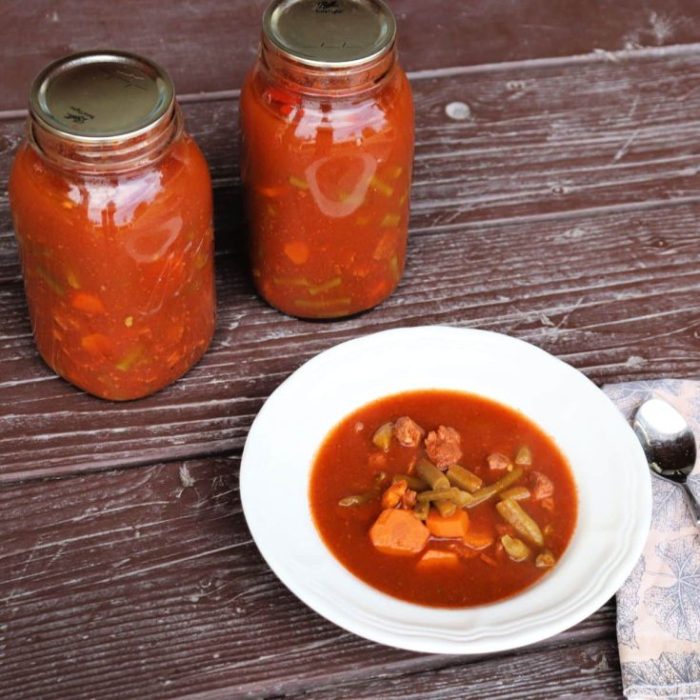
Source: rootsy.org
This section details the creation of a hearty canned vegetable soup, emphasizing flavor enhancement techniques.
Hearty Canned Vegetable Soup Recipe
- Ingredients: 1 tbsp olive oil, 1 onion (chopped), 2 cloves garlic (minced), 1 (28 oz) can diced tomatoes, 1 (15 oz) can mixed vegetables, 4 cups vegetable broth, 1 tsp dried oregano, 1/2 tsp dried basil, salt and pepper to taste.
- Procedure: Sauté onion and garlic in olive oil until softened. Add diced tomatoes, mixed vegetables, vegetable broth, oregano, and basil. Bring to a boil, then reduce heat and simmer for 15 minutes. Season with salt and pepper to taste.
Herbs and spices significantly impact flavor. Fresh herbs such as parsley, thyme, and rosemary add bright, herbaceous notes. Spices like cumin, coriander, and turmeric provide warmth and depth. The choice of broth (chicken, beef, or vegetable) profoundly influences the overall taste. Chicken broth lends a savory richness, beef broth adds a bolder, umami flavor, and vegetable broth offers a clean, neutral base.
Adjusting consistency involves simmering the soup longer to thicken it or adding more broth to thin it. A cornstarch slurry can also be used for thickening.
Serving Suggestions and Recipe Adaptations
This section explores creative serving suggestions and dietary adaptations.
Three creative serving suggestions include a dollop of sour cream or crème fraîche, a sprinkle of fresh herbs (parsley, chives), or crusty bread for dipping. Adapting the recipe for different dietary needs is straightforward. For vegetarian diets, ensure the broth is vegetable-based. Vegan adaptations require omitting dairy products and using plant-based alternatives like coconut milk. Gluten-free adaptations are naturally achieved as the basic recipe is inherently gluten-free.
A visually appealing presentation features a deep bowl filled with vibrant-colored vegetables. A swirl of cream or a sprinkle of herbs adds visual interest. Garnish with croutons or a sprinkle of cheese (if not vegan).
Proper storage involves cooling the soup completely before transferring it to airtight containers. Refrigerate for up to 3 days or freeze for longer storage.
Advanced Techniques and Recipe Ideas, Vegetable soup with canned vegetables recipes
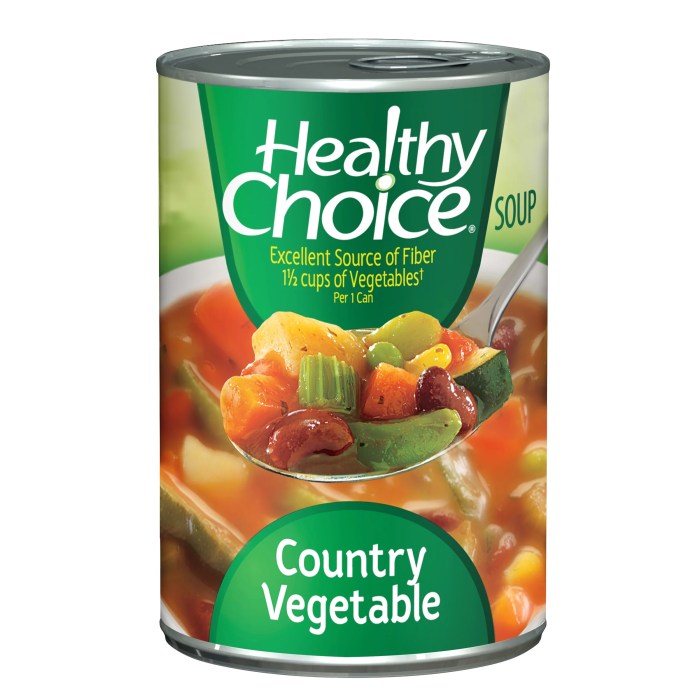
Source: walmartimages.com
This section explores advanced techniques and recipe ideas.
Using homemade broth enhances flavor significantly, offering a depth of taste unavailable in commercial broths. Adding texture can be achieved by incorporating cooked noodles, rice, or croutons. A creamy version can be made by adding coconut milk or cream during the simmering process.
Creamy Coconut Vegetable Soup
- Ingredients: Follow the basic recipe, substituting coconut milk for half of the vegetable broth.
- Procedure: Simmer as directed, adding the coconut milk during the last 5 minutes of cooking.
Freezing canned vegetable soup is simple. Cool completely, then transfer to freezer-safe containers, leaving some headspace for expansion. The soup can be frozen for up to 3 months.
Top FAQs: Vegetable Soup With Canned Vegetables Recipes
Can I use frozen vegetables instead of canned?
Yes, but adjust cooking time accordingly. Frozen vegetables often require less cooking time than canned.
How long can I store leftover soup?
Store leftover soup in an airtight container in the refrigerator for up to 3-4 days.
What if my soup is too thick or too thin?
Add broth or water to thin, and simmer to thicken. A cornstarch slurry can also help thicken.
Vegetable soup with canned vegetables offers a quick and convenient meal, perfect for busy weeknights. For a heartier option with a similar ease of preparation, consider exploring alternative recipes like those found in our collection of turkey rice soup recipes ; they offer a protein boost and a different flavor profile. Ultimately, both canned vegetable soup and turkey rice soup provide satisfying, nourishing meals with minimal cooking time.
Can I make this soup vegan?
Yes, use vegetable broth and ensure all other ingredients are vegan-friendly.


